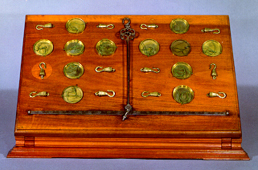
38 x 58.8 x 6 (balance)
35.5 x 36 x 70 (case)
Wood, iron and brass
INDEX 1788 : C.II.103
Libra, quae arithmetica vocatur, utrinque aequales in partes divisa, cui ad varias ab axe distantias pondera diversa pro statu aequilibrii applicantur, ut ostendatur quomodo momenta corporum Machinas praementium sunt supputanda.
Balance that is called arithmetic, divided on both sides in equal parts, to which in varied distances from the axle, various weights are applied in order to maintain equilibrium; to show how the moments of the bodies that the machine carries should be counted.
This model of balance was used in the experimental study of the condition of equilibrium. Bodies of a variety of different masses could be suspended on the metal arms of this balance. Each of the two arms is divided into 10 equal parts, marked by large dashes, each one subdivided into 10 parts, marked with smaller dashes. In the middle of the beam there is a pointer 26.5 cm in length. Twelve pans and twelve hooks to suspend the pans from the beam, contribute to the assemblage. The plates and the hooks are made of brass.
This balance should be installed on a stand (instrument 24) in order for it to be used properly. After mounting it, the suspension hooks and pans should be distributed and bodies of a known weight placed in them until the balance reaches equilibrium. The levelling must be controlled via the pointer, as soon as the beam is in a horizontal position. If we were to suspend n pans on one arm, and m pans on the other arm, the condition of equilibrium would be given by the following formula: F1 d1 + F2 d2 + ... + Fn dn = F'1 d'1+ F'2 d'2 + ... + F'm d'm where F1, F2, ... Fn represents the weight of each of the sets composed by the bodies and respective pans and hooks, while d1, d2, ... dn represent the distances of the fulcrum of the balance at the suspension points of the pans. The quantities of the second member of the equality have the same meaning, but refer to the other arm of the balance.
All of the pieces of the balance are kept in the sculpted cavities of a wooden board 2.5 cm thick, which exhibits them in an inclined position resting on a wooden support which is found on the back part of the board.
From Colégio dos Nobres, catalogue n.º 95.
's Gravesande, Willem Jacob, Physices Elementa, Leiden, 1742, Vol. I, p. 42, Tab. V.